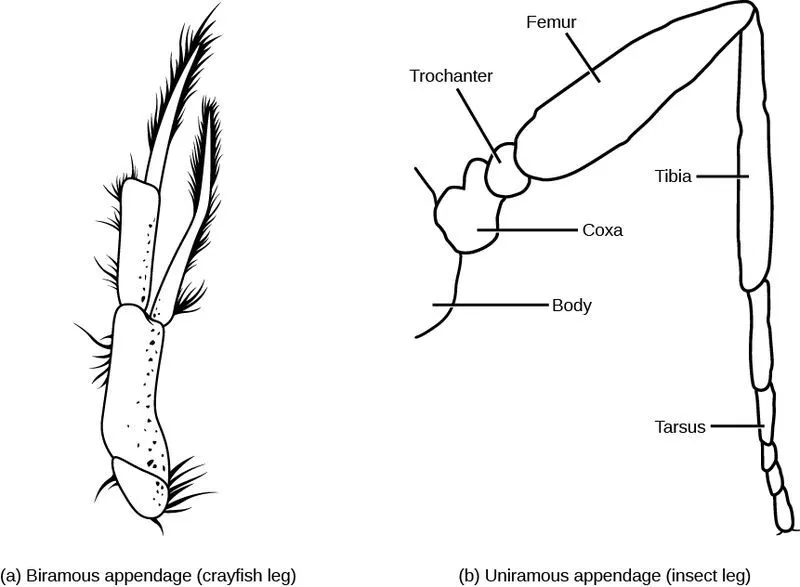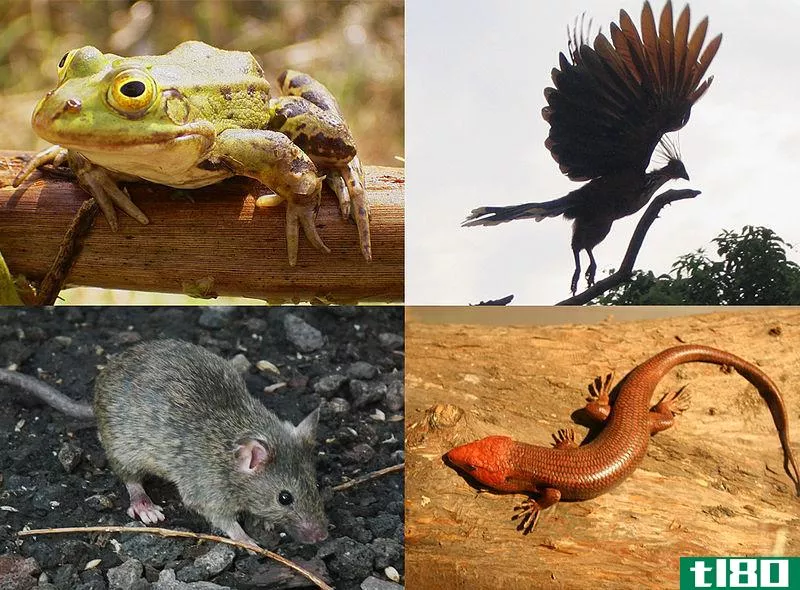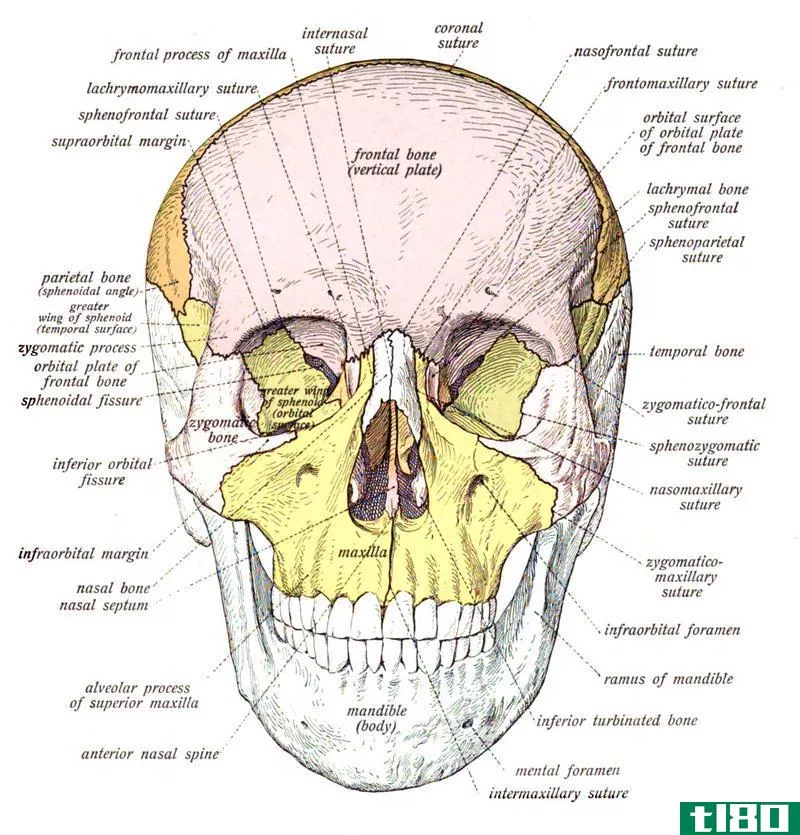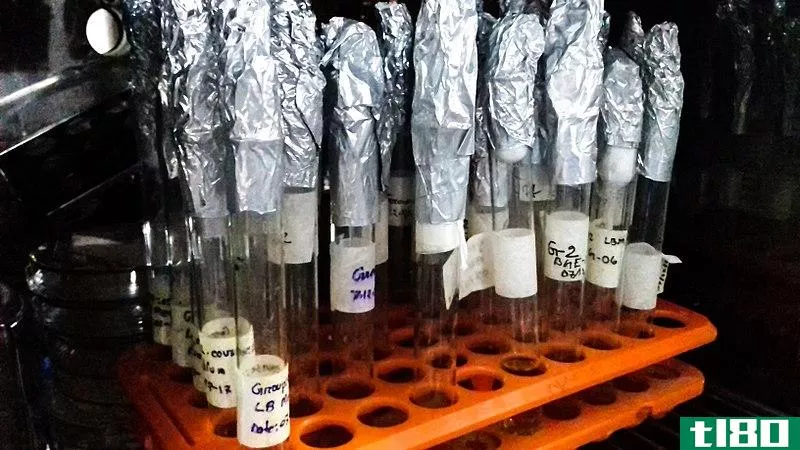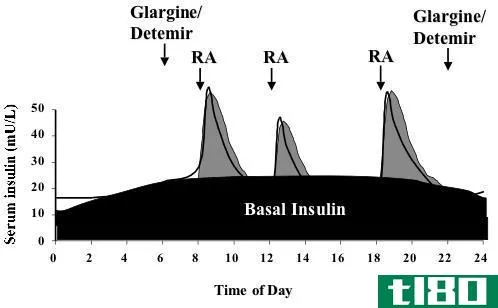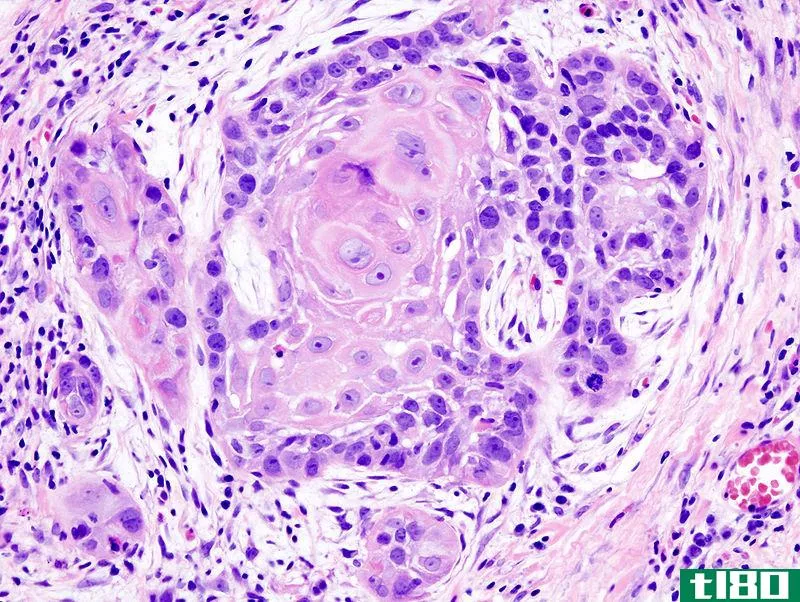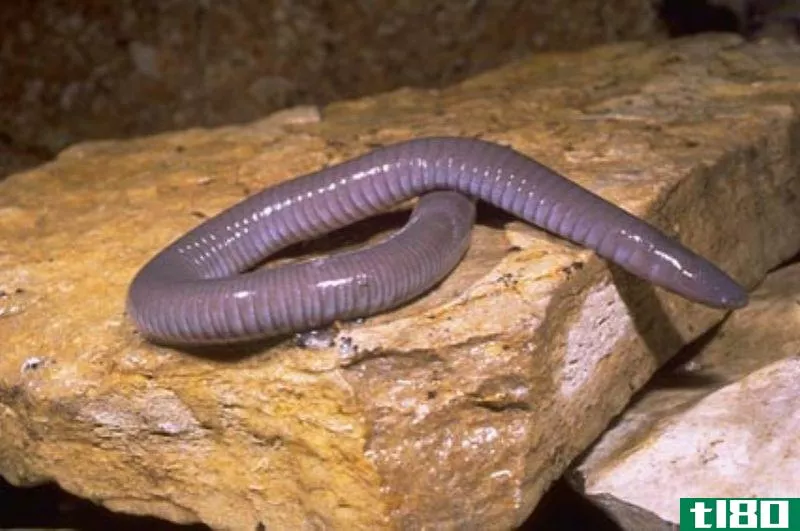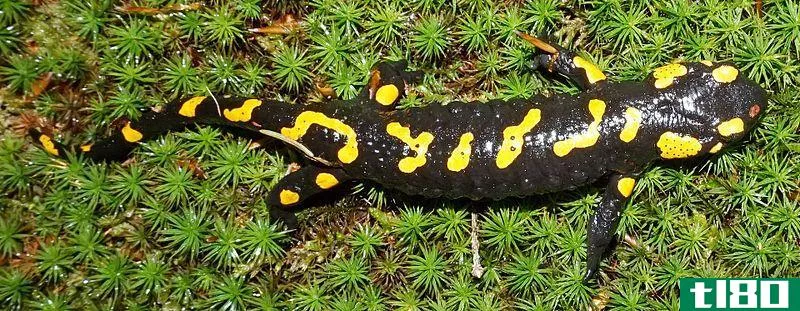什么是基层四肢动物?(basal tetrapods?)

基部四足动物是指位于四足动物进化树根部的四足动物(四条腿的动物),其中包括所有陆生脊椎动物,甚至一些海洋动物,如鲸类:鲸和亲属。 基部四足动物从石龙鱼类(叶鳍鱼)进化而来,今天的化石是浣熊鱼和肺鱼。
3.8亿年前,在泥盆纪时期,陆地上没有后来所有时代都有的茂密森林。 真正的树木刚刚开始进化,但原始的维管束植物随处可见,形成了矮小的灌木状森林。 这些森林中居住着节肢动物,如螨虫、蝎子和有蹄类动物,以及一些简单的软体动物,这些动物的化石效果并不好。 奇怪的真菌单体Prototaxites,高度可达9米(30英尺),是周围最高的东西。 地球很温暖,导致大陆架被淹没,低地上有营养丰富的沼泽。 这种环境非常适合鼓励一个小家族鱼进化出更强大的底鳍,用于推动自己穿过浅沼泽的植物。
早期的叶鳍鱼,如生活在3.8亿年前的Eusthenopteron,已知拥有许多今天已知的四足动物独有的特征:内鼻孔、带有颅间关节的两部分颅骨,最值得注意的是,前鳍有桡骨、尺骨和肱骨,盆鳍有腓骨、胫骨和股骨。 现在已知最后一个特征是所有鳞翅目动物共有的。
大约在同一时期,有一种浅水鱼Panderichthys,它具有更多类似四足动物的基本特征,特别是一个宽大的、类似四足动物的头部。 Panderichthys是一个关键的过渡性化石,显示了骨盆腰带进化的中间点,这使得基本的四足动物的腿成为可能。 它的头部甚至有一个螺旋桨,或氧气呼吸管,后来演变成四足动物耳朵的镫骨。 这使它在氧气不足的泥水中能够充分呼吸。
Living approximately 475 million years ago was the famous Tiktaalik, reconstructions and analysis of which most clearly show an intermediary form between a fish and amphibian. It is unknown whether Tiktaalik was a true tetrapod, venturing on land, although it does seem likely. Studies of the skeleton of Tiktaalik have shown it could have supported its own weight on hand. Its fins had a wrist structure not seen in any earlier fish. Its head had spiracles of substantial size which probably channeled oxygen to primitive lungs. This sarcopterygian even had a wide, crocodile-like head which it could turn to the left and right, independently of its body, an adaptation ideal for hunting on land and unlike any fish before it. Tiktaalik is the best-preserved sarcopterygians to be classified in the subclass Tetrapodomorpha. Tiktaalik, and earlier members of Tetrapodmorpha, like Kenichthys, are considered so similar to basal tetrapods that they have been called "fishapods," in reference to their combination of fish and
One of the first true tetrapods, which still probably didn't predominantly walk on land, but did use its primitive legs to navigate through swamps, was Ichthyostega, which lived 367-362.5 million years ago. Ichthyostega is one of a few basal tetrapods, a tetrapod that is neither an amphibian, synapsid (mammal and relatives), or sauropsid (reptile). These animals had a number of further evolutionary innovations for terrestrial life. For one, Ichthyostega primarily used its lungs to breathe, rather than its gills. It had a special skin covering which helped prevent it from drying out. It had a skeletal structure (especially spine and ribcage) that clearly shows this animal spent major time holding itself up. Ichthyostega and other ichthyostegoids (Acanthostega, Elginerpeton, Ichthyostega, and others) were eventually replaced by temnospondyls and anthracosaurs, including the famous Eryops. Unfortunately, there is a 20-30 million year gap in the fossil record between both groups, only bridged by a few specimens.
- 发表于 2022-02-09 12:41
- 阅读 ( 141 )
- 分类:科学
你可能感兴趣的文章
双性恋(biramous)和单枝节肢动物(uniramous arthropods)的区别
...的腿,而甲壳类动物有双腿。 目录 1. 概述和主要区别 2. 什么是双性节肢动物 3. 什么是单肢节肢动物 4. 双性节肢动物与单分支节肢动物的相似性 5. 并列比较-双性和单分支节肢动物的表格形式 6. 摘要 什么是双性节肢动物(biramous...
- 发布于 2020-09-28 02:22
- 阅读 ( 331 )
四足动物(tetrapods)和两栖动物(amphibians)的区别
...四足动物与两栖动物的表格形式 6. 摘要 什么是四足动物(tetrapods)? 四足动物主要是四肢的脊椎动物。许多爬行动物,许多两栖动物,所有哺乳动物和所有鸟类都属于这一类。这意味着大多数脊椎动物是四足动物,但并非全部。...
- 发布于 2020-10-08 20:56
- 阅读 ( 371 )
基底骨(basal bone)和牙槽骨(alveolar bone)的区别
...槽骨则是排列在牙槽中的骨。 目录 1. 概述和主要区别 2. 什么是基底骨 3. 什么是牙槽骨 4. 基底骨与牙槽骨的相似性 5. 并列比较-基底骨与牙槽骨的列表形式 6. 摘要 什么是基底骨(basal bone)? 基骨是下颌骨和上颌骨的骨组织,而...
- 发布于 2020-10-13 22:31
- 阅读 ( 309 )
基底(basal)和完整介质(complete media)的区别
...基是两种类型的生长培养基。 目录 1. 概述和主要区别 2. 什么是完全媒体 3. 什么是基础培养基 4. 基底和完全介质的相似性 5. 并列比较-表格形式的基础和完整介质 6. 摘要 什么是基础培养基(basal media)? 基本培养基,又称简单培...
- 发布于 2020-10-15 10:02
- 阅读 ( 155 )
基底神经节(basal ganglia)和小脑(cerebellum)的区别
...常的大脑功能和行为很重要。 目录 1. 概述和主要区别 2. 什么是基底神经节 3. 什么是小脑 4. 基底神经节与小脑的相似性 5. 并列比较-基底节与小脑的表格形式 6. 摘要 什么是基底神经节(basal ganglia)? 基底神经节是中枢神经系统...
- 发布于 2020-10-15 10:38
- 阅读 ( 846 )
基底(basal)和胰岛素丸(bolus insulin)的区别
...模拟人体的天然胰岛素功能。 目录 1. 概述和主要区别 2. 什么是基础胰岛素 3. 什么是胰岛素丸 4. 基础胰岛素与大剂量胰岛素的相似性 5. 并列比较-基础胰岛素与单剂量胰岛素的表格形式 6. 摘要 什么是基础胰岛素(basal insulin)? ...
- 发布于 2020-10-15 11:26
- 阅读 ( 960 )
基底细胞癌(basal cell carcinoma)和鳞状细胞癌(squamous cell carcinoma)的区别
...的相似性 5. 并列比较-基底细胞癌与鳞状细胞癌 6. 摘要 什么是鳞状细胞癌(squamous cell carcinoma)? 鳞状上皮见于皮肤、**、口腔、小气道和其他一些地方。快速分裂和更新的组织更容易患癌症。因此,在鳞状细胞覆盖的区域发现了...
- 发布于 2020-11-03 06:04
- 阅读 ( 418 )
四肢两栖动物(limbless amphibians)和蛇(snakes)的区别
...无肢两栖动物也成为受害者。 目录 1. 概述和主要区别 2. 什么是无肢两栖动物 3. 什么是蛇 4. 无肢两栖动物和蛇的相似之处 5. 并列比较-无肢两栖动物与蛇的表格形式 6. 摘要 什么是四肢两栖动物(limbless amphibians)? 无腿两栖动物...
- 发布于 2020-11-05 15:37
- 阅读 ( 284 )
无尾尿道(urodela anura)和apoda公司(apoda)的区别
...群体的大小和结构各不相同。 目录 1. 概述和主要区别 2. 什么是Urodela 3. 阿努拉是什么 4. 什么是Apoda 5. 无尾熊与Apoda的相似性 6. 并排比较-以表格形式比较Urodela与Anura与Apoda 7. 摘要 什么是泌尿系(urodela)? Urodela是两栖动物的一个...
- 发布于 2021-03-04 19:54
- 阅读 ( 309 )
灵长类(primates)和非灵长类(non primates)的区别
...和大象是一些聪明的非灵长类动物。 覆盖的关键领域 1.什么是灵长类-定义、事实、特征2.什么是非灵长类-定义、事实、特征3.灵长类和非灵长类之间的相似之处是什么-共同特征概述4.灵长类和非灵长类之间的区别是什么-主要区...
- 发布于 2021-06-29 23:17
- 阅读 ( 282 )
